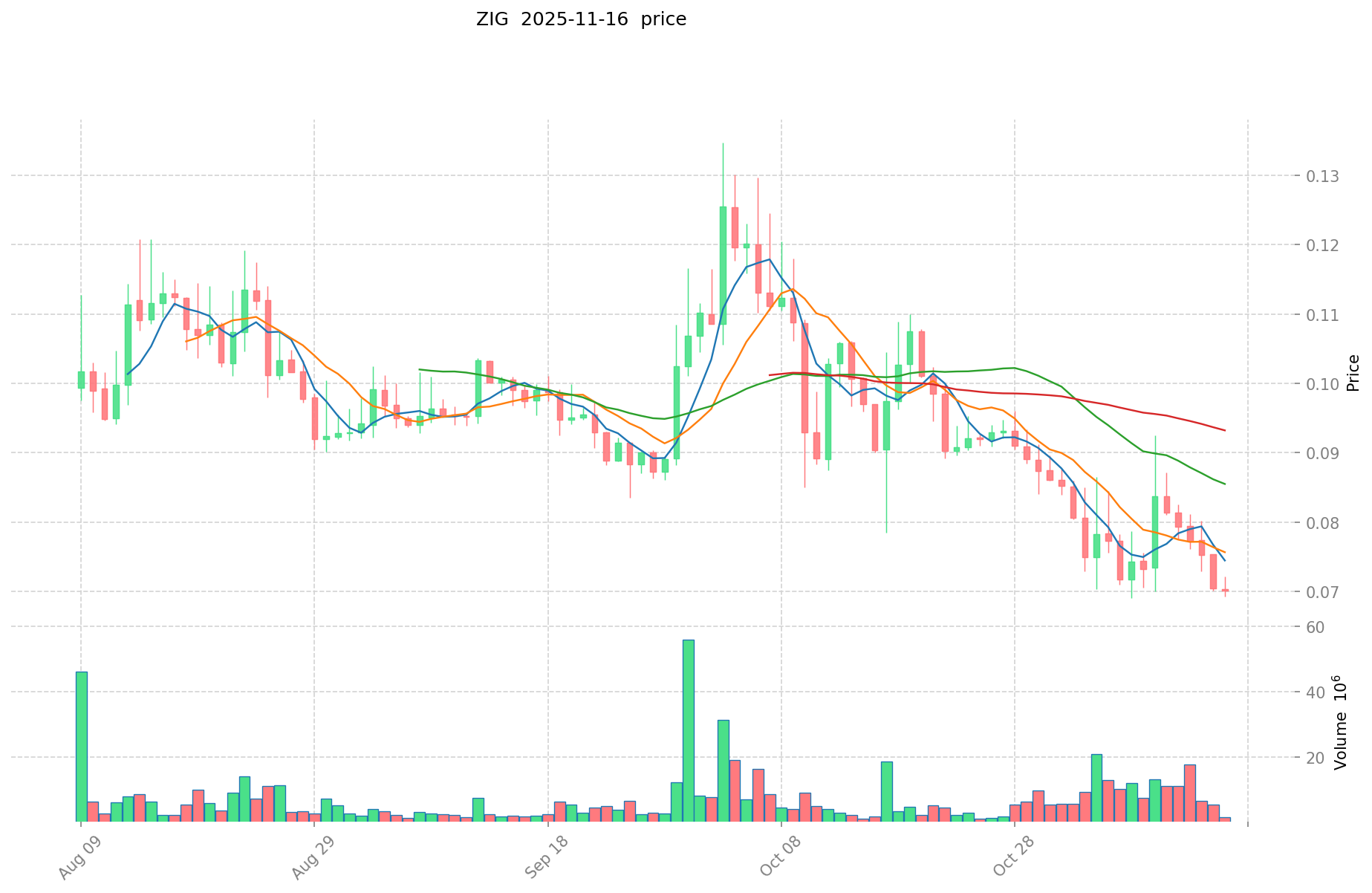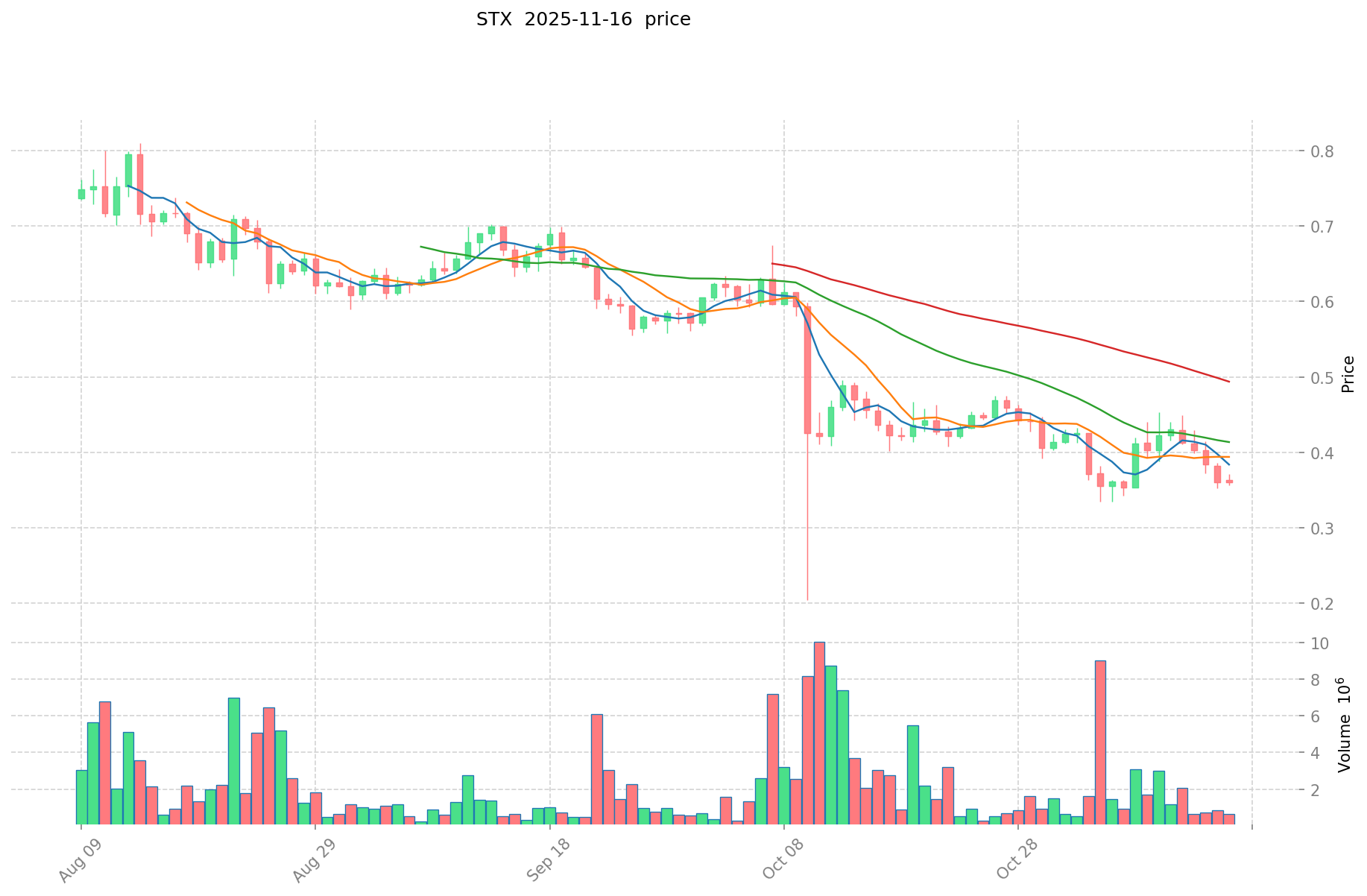ZIG vs STX: Comparing Two Emerging Cryptocurrencies in the DeFi Landscape
Introduction: ZIG vs STX Investment Comparison
In the cryptocurrency market, the comparison between ZIG and STX has always been a topic that investors cannot avoid. The two not only differ significantly in market cap ranking, application scenarios, and price performance, but also represent different cryptocurrency asset positioning.
ZIGChain (ZIG): Since its launch in 2018, it has gained market recognition for its vision of democratizing wealth generation.
Stacks (STX): Introduced in 2019, it has been hailed as a new decentralized internet for applications, aiming to give users better control over their data.
This article will comprehensively analyze the investment value comparison between ZIG and STX, focusing on historical price trends, supply mechanisms, institutional adoption, technological ecosystems, and future predictions, attempting to answer the question investors care about most:
"Which is the better buy right now?"
I. Price History Comparison and Current Market Status
ZIG and STX Historical Price Trends
- 2021: ZIG reached its all-time high of $0.224179 on April 15, 2021.
- 2024: STX hit its all-time high of $3.86 on April 1, 2024.
- Comparative analysis: ZIG has fallen from its ATH of $0.224179 to a current price of $0.06885, while STX has dropped from its peak of $3.86 to $0.3559.
Current Market Situation (2025-11-16)
- ZIG current price: $0.06885
- STX current price: $0.3559
- 24-hour trading volume: ZIG $118,824.99 vs STX $154,852.35
- Market Sentiment Index (Fear & Greed Index): 10 (Extreme Fear)
Click to view real-time prices:
- View ZIG current price Market Price
- View STX current price Market Price


II. Core Factors Influencing ZIG vs STX Investment Value
Supply Mechanisms Comparison (Tokenomics)
- ZIG: Fixed supply model with a maximum of 10 billion tokens
- STX: Supply mechanism tied to Bitcoin's mining schedule with a maximum cap of approximately 1.818 billion tokens
Institutional Adoption and Market Applications
- Institutional Holdings: Limited institutional presence for both tokens currently
- Enterprise Adoption: STX has gained more enterprise attention through its Bitcoin layer-2 capabilities and Clarity smart contract language
- National Policies: Regulatory treatment varies by jurisdiction, with both tokens facing similar regulatory scrutiny as emerging crypto assets
Technical Development and Ecosystem Building
- STX Technical Upgrades: Implementation of Nakamoto release improving scalability and security through new consensus mechanism
- ZIG Technical Development: Focus on platform development and third-party integrations
- Ecosystem Comparison: STX has a more developed ecosystem with DeFi applications, NFTs, and Bitcoin-connected smart contracts, while ZIG is still building its ecosystem
Macroeconomic and Market Cycles
- Performance in Inflationary Environments: STX potentially benefits from association with Bitcoin's inflation-resistant properties
- Macroeconomic Monetary Policy: Both tokens influenced by broader crypto market reactions to interest rates and dollar strength
- Geopolitical Factors: Cross-border transaction demand potentially benefits both, with STX leveraging Bitcoin's established global presence
III. 2025-2030 Price Prediction: ZIG vs STX
Short-term Prediction (2025)
- ZIG: Conservative $0.0646532 - $0.06878 | Optimistic $0.06878 - $0.0852872
- STX: Conservative $0.24948 - $0.3564 | Optimistic $0.3564 - $0.488268
Mid-term Prediction (2027)
- ZIG may enter a growth phase, with estimated prices of $0.07137933376 - $0.10619852096
- STX may enter a steady growth phase, with estimated prices of $0.4386783258 - $0.5226805584
- Key drivers: Institutional capital inflow, ETFs, ecosystem development
Long-term Prediction (2030)
- ZIG: Base scenario $0.130504185156912 - $0.146026709382624 | Optimistic scenario $0.146026709382624 - $0.176180649961831
- STX: Base scenario $0.641389480096365 - $0.75683958651371 | Optimistic scenario $0.75683958651371 - $0.75683958651371
Disclaimer
ZIG:
| 年份 | 预测最高价 | 预测平均价格 | 预测最低价 | 涨跌幅 |
|---|---|---|---|---|
| 2025 | 0.0852872 | 0.06878 | 0.0646532 | 0 |
| 2026 | 0.097062336 | 0.0770336 | 0.043138816 | 11 |
| 2027 | 0.10619852096 | 0.087047968 | 0.07137933376 | 26 |
| 2028 | 0.1333400773824 | 0.09662324448 | 0.0879271524768 | 40 |
| 2029 | 0.146026709382624 | 0.1149816609312 | 0.09198532874496 | 67 |
| 2030 | 0.176180649961831 | 0.130504185156912 | 0.109623515531806 | 89 |
STX:
| 年份 | 预测最高价 | 预测平均价格 | 预测最低价 | 涨跌幅 |
|---|---|---|---|---|
| 2025 | 0.488268 | 0.3564 | 0.24948 | 0 |
| 2026 | 0.51102414 | 0.422334 | 0.40966398 | 18 |
| 2027 | 0.5226805584 | 0.46667907 | 0.4386783258 | 31 |
| 2028 | 0.578775382614 | 0.4946798142 | 0.252286705242 | 38 |
| 2029 | 0.74605136178573 | 0.536727598407 | 0.33813838699641 | 50 |
| 2030 | 0.75683958651371 | 0.641389480096365 | 0.346350319252037 | 80 |
IV. Investment Strategy Comparison: ZIG vs STX
Long-term vs Short-term Investment Strategy
- ZIG: Suitable for investors focused on wealth generation platforms and ecosystem potential
- STX: Suitable for investors interested in Bitcoin-connected smart contracts and decentralized internet applications
Risk Management and Asset Allocation
- Conservative investors: ZIG: 30% vs STX: 70%
- Aggressive investors: ZIG: 60% vs STX: 40%
- Hedging tools: Stablecoin allocation, options, cross-currency portfolios
V. Potential Risk Comparison
Market Risk
- ZIG: Higher volatility due to lower market cap and trading volume
- STX: Susceptible to Bitcoin market movements due to its connection with the Bitcoin ecosystem
Technical Risk
- ZIG: Platform scalability, network stability
- STX: Consensus mechanism reliability, smart contract vulnerabilities
Regulatory Risk
- Global regulatory policies may impact both tokens, with potentially greater scrutiny on STX due to its Bitcoin connection
VI. Conclusion: Which Is the Better Buy?
📌 Investment Value Summary:
- ZIG advantages: Fixed supply model, focus on wealth generation platform
- STX advantages: Bitcoin layer-2 capabilities, more developed ecosystem with DeFi and NFT applications
✅ Investment Advice:
- Novice investors: Consider a higher allocation to STX due to its more established ecosystem
- Experienced investors: Balanced approach with exposure to both tokens, leveraging ZIG's growth potential and STX's Bitcoin connection
- Institutional investors: Focus on STX for its enterprise adoption and Bitcoin-related properties
⚠️ Risk Warning: The cryptocurrency market is highly volatile. This article does not constitute investment advice. None
VII. FAQ
Q1: What are the main differences between ZIG and STX? A: ZIG focuses on democratizing wealth generation, while STX aims to create a decentralized internet for applications. ZIG has a fixed supply of 10 billion tokens, whereas STX's supply is tied to Bitcoin's mining schedule with a cap of about 1.818 billion tokens. STX has a more developed ecosystem with DeFi and NFT applications, while ZIG is still building its ecosystem.
Q2: Which token has performed better historically? A: STX has shown better historical performance, reaching an all-time high of $3.86 on April 1, 2024, compared to ZIG's all-time high of $0.224179 on April 15, 2021. However, both have seen significant drops from their peak prices.
Q3: What are the key factors influencing the investment value of ZIG and STX? A: Key factors include supply mechanisms, institutional adoption, technical development, ecosystem building, macroeconomic conditions, and market cycles. STX benefits from its Bitcoin connection and more developed ecosystem, while ZIG offers potential in the wealth generation platform space.
Q4: How do the price predictions for ZIG and STX compare for 2030? A: For 2030, ZIG's base scenario predicts a range of $0.130504185156912 - $0.146026709382624, with an optimistic scenario of up to $0.176180649961831. STX's base scenario for 2030 is $0.641389480096365 - $0.75683958651371, with the same upper limit for the optimistic scenario.
Q5: What are the main risks associated with investing in ZIG and STX? A: Both tokens face market risks, technical risks, and regulatory risks. ZIG may experience higher volatility due to its lower market cap and trading volume. STX is susceptible to Bitcoin market movements and may face greater regulatory scrutiny due to its Bitcoin connection.
Q6: How should investors allocate their portfolio between ZIG and STX? A: Conservative investors might consider allocating 30% to ZIG and 70% to STX, while aggressive investors might opt for 60% ZIG and 40% STX. The allocation should be based on individual risk tolerance and investment goals.
Q7: Which token is considered a better buy for different types of investors? A: Novice investors might consider a higher allocation to STX due to its more established ecosystem. Experienced investors could take a balanced approach with exposure to both tokens. Institutional investors might focus on STX for its enterprise adoption and Bitcoin-related properties.
Share
Content